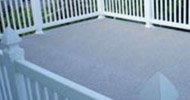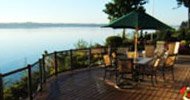VP building a free standing deck in Toronto
by VP
(Toronto, ON, Canada)
I'm "stuck" - can someone provide some feedback....
I am planning on building a free standing deck (34' across x 16' deep), with an added gazebo (10' x 10') - one step up - partly overlapping deck on end corner
My plan is as follows:
- 18" high from top of concrete pier to top of deck, level with door
- use (3) beams - (2)x2x8 and 2x8 joists
- use 12" dia sono tube - 4' deep (marked "x" below)
- there is a 30" bay window on one end and a 30" x 12' section of disturbed soil down to the footings due to digging for waterproofing,approx.6 yrs. ago.
Can I cantilever over this distance, say 36" or more to the house wall, and still be sturdy?
Can I get away with using less footings?
Can I attach beams directly to concrete piers (on metal post bracket - no wooden post)due to height restriction?
Any alternatives - please feel free to comment.
The frost line here is 40-42" (Toronto, Ontario, Canada)


























